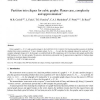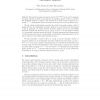30 search results - page 4 / 6 » Large induced subgraphs with equated maximum degree |
DAM
2008
13 years 7 months ago
2008
Given a graph G = (V, E) and a positive integer k, the PARTITION INTO CLIQUES (PIC) decision problem consists of deciding whether there exists a partition of V into k disjoint sub...
IWOCA
2009
Springer
14 years 1 months ago
2009
Springer
: We present an improved upper bound of O(d1+ 1 m−1 ) for the (2, F)-subgraph chromatic number χ2,F (G) of any graph G of maximum degree d. Here, m denotes the minimum number of...
NETWORKING
2007
13 years 8 months ago
2007
Multicasting is one of the most important applications in Wireless Ad hoc Networks and the currently emerging Wireless Mesh Networks. In such networks, interference due to the shar...
COMBINATORICS
2006
13 years 7 months ago
2006
A set M of edges of a graph G is a matching if no two edges in M are incident to the same vertex. The matching number of G is the maximum cardinality of a matching of G. A set S o...
COMBINATORICA
2010
13 years 4 months ago
2010
In this paper, we propose a simple and natural randomized algorithm to embed a tree T in a given graph G. The algorithm can be viewed as a "self-avoiding tree-indexed random ...


